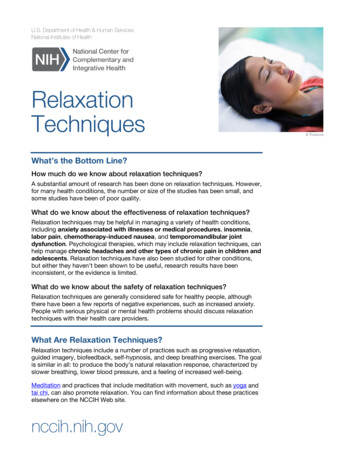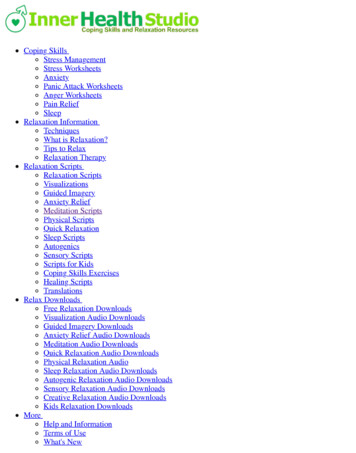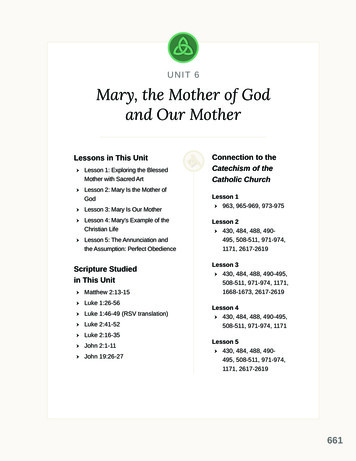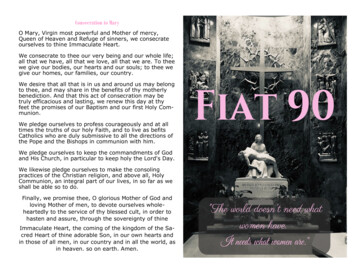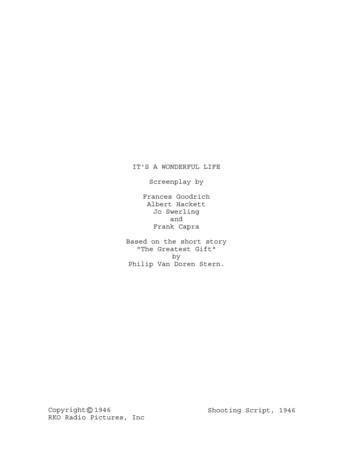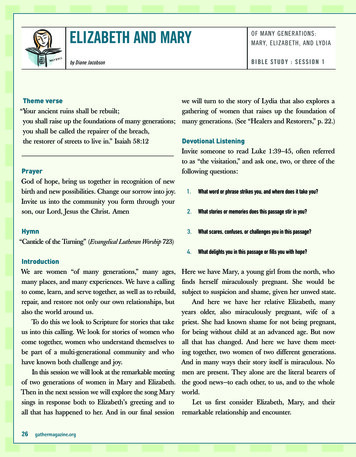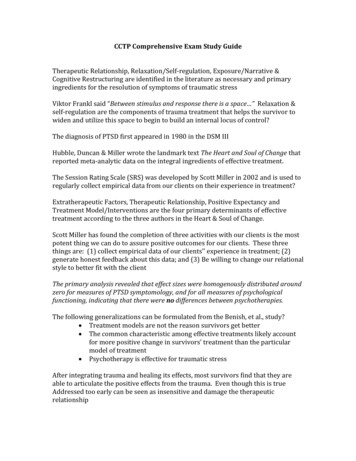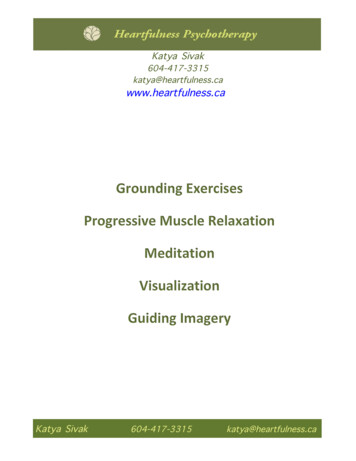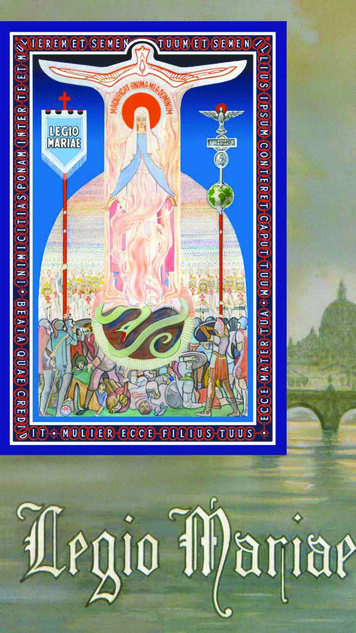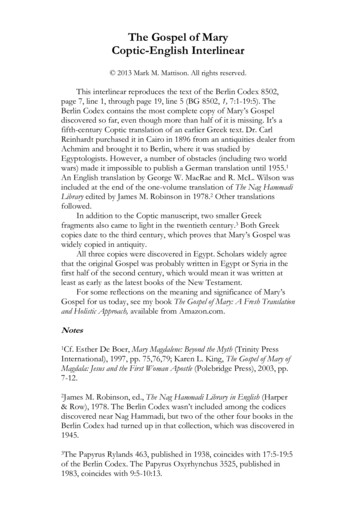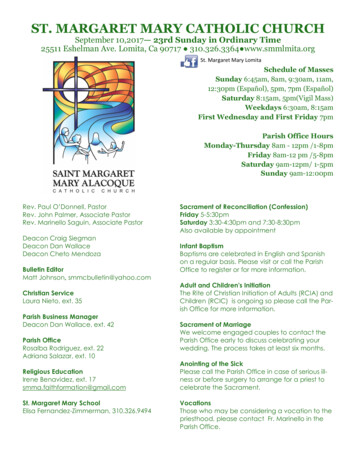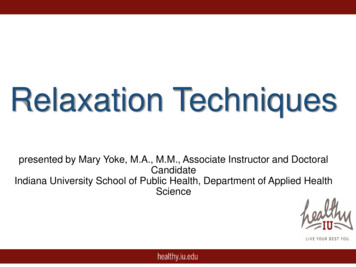
Transcription
Relaxation Techniquespresented by Mary Yoke, M.A., M.M., Associate Instructor and DoctoralCandidateIndiana University School of Public Health, Department of Applied HealthScience
Presentation brought to you by
Our Main Objectives: For you to experience 8 differentrelaxation techniques For you to leave this session with adoable plan for incorporating periodsof relaxation into your day
So How Do You Relax?
Relaxation Technique #1:Take a Deep Breath!!
Relaxation: WHAT IS IT? The state of being free from tension and anxiety The restoration of equilibrium following disturbance The process of effectively moving the mind/body fromthe stress response to the relaxation response
Benefit of relaxation: TheRelaxation Response Decreased heart rate Decreased blood pressure Slowed breath rate Decreased need for oxygen Increased blood flow Reduced muscle tension Decreased incidence of headaches and muscle pain Fewer emotional responses such as anger, crying, anxiety, apprehension, andfrustration Improved concentration Better ability to handle problems(Benson, 1983, 1997: Benson & Proctor, 2011; Dusek, Chang, Zaki, et al, 2006; Dusek, Out, Wohlhueter, et al, 2008; Morita, Sato,Ohta, et al, 2005; Nakao, Myers, Fricchione, et al, 2001; Pilay, 2010, 2011).
Relaxation Techniques CanHelp Relieve Pain Source: “Relaxation as Treatment for Chronic Musculoskeletal Pain: A Systematic Review ofRandomized Controlled Studies,” by Gunvor Gard et al. Physical Therapy Reviews, 13(5) (2008):355–365
Just as we have a stressresponse, we also have arelaxation response.We have the power to resetour bodies almost instantly.
Tips for all relaxation techniques: Not all techniques work for every person—experiment to see what’sbest for you Try each method several times Give yourself a minimum of 10-15 minutes/day to practice a relaxationactivity Seclude yourself where you will not be interrupted Minimize background noises Approach each technique without expectations Keep an open mind
Tips for Facilitating Relaxation
Relaxation Sensations TinglingWarmthCoolnessFloatingHeavinessPleasant numbnessDistortions in yoursense of time
Relaxation Technique #2: Stretch—andconnect your breathing to yourmovement. Do this is such a way that itfeels good and makes you happy to bealive!
The Joy of Breathing Feel life-giving oxygen fully entering your bodyon the inhale. Intentionally stretch your lungsopen and rejoice in your ability to breathe. Lengthen your exhale, letting all tension flowout of the body. Pause slightly after exhaling, and let yourselffeel a sense of peace.
Relaxation Technique #3: Try amantra or affirmative phrase withyour breathing
Why? inconstant-confused-indecisive-uncontrollable
Relaxation Technique #4: Takea 60-second vacation
Where do you want to go?
Relaxation Technique #5: TrySome Chair/Office Yoga
Relaxation Technique #6:MASSAGE
Relaxation Technique #7:
Muscle Physiology
But. . . .
Progressive Muscle Relaxation
How to do Progressive Muscle Relaxation
ProgressiveMuscleRelaxation
Relaxation Technique #8:Meditation A conscious mental method of systematicallyallowing the mind to focus on a single thought,word, or space The mind thinks more clearly Relaxation is the result
Meditation is a great way torecover and restore balance toyour life
Many Types of Meditation: Transcendental meditation Zen (Zazen) meditation Vipassana Mindfulness meditation Loving-kindness (metta) meditation Vedic meditation Chakra meditation Kundalini meditation I am (atma vichara) meditation Qigong meditation Christian meditation (e.g. contemplative prayer)
Meditation techniques Focus on the breath. Think only of thisinhale, then think only of the nextexhale, and so on. Use a slow counting pattern for eachbreath. E.g. inhale to the count of 4;exhale to the count of 5 Count slowly backwards with eachbreath. E.g. start with 10—inhale andexhale, then 9—inhale and exhale, etc. Use a mantra or phrase
Mantra A repeated sound, word, or phraseused as a point of focus duringmeditation Examples:- peace (inhale), love (exhale)- calm (inhale), smile (exhale)- om (peace or oneness)
for Meditation EXAMPLES: Peace is my true nature I am an eternal spark of life energy I find deep peace and contentment within I am awake to the beauty of life
Meditation Tips Sit tall with a long spine; sit withdignity Use a cushion or block to sit on, orsit on a chair with both feetgrounded Eyes closed Hands in a comfortable position(mudra), generally with palms up
Loving-kindness meditation(mettas) Usually silently repeated all the waythrough 3 times: 1) for yourself—”I”,2) for someone close to you or whois in need—”you”, 3) for a largergroup—”we”.- May I be healthy and strong- May I be happy and peaceful- May I be free from inner and outer harm- May I take care of myself with wisdom, love,joy, and compassion
What’s Your Plan forRelaxation?WE COVERED:1. Deep, relaxing, mindful breathing.2. Simple stretching3. Using a mantra or phrase to calm your mind whiledeep breathing4. Taking a 60-second vacation5. Chair/ office yoga6. DIY massage7. Progressive muscle relaxation8. Meditation
Make a Plan!1. Write down when and where you could do one or more ofthese techniques tomorrow.2. Start with a shorter duration—how much time will youtake? Do you need a timer? How many times per day?3. What relaxation technique(s) will you do?4. How will you remind yourself to do a relaxation techniquetomorrow and on other days?5. How can you remind yourself to practice mindful breathingthroughout the day?
“May the light within me honorthe light within you”
Meditation techniques Focus on the breath. Think only of this inhale, then think only of the next exhale, and so on. Use a slow counting pattern for each breath. E.g. inhale to the count of 4; exhale to the count of 5 Count slowly backwards with each breath. E.g. start
